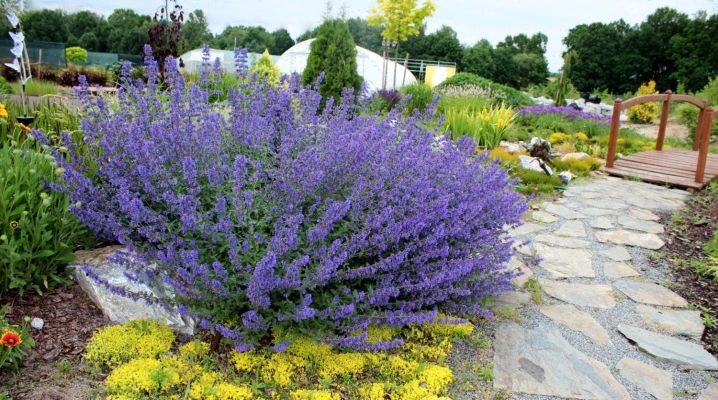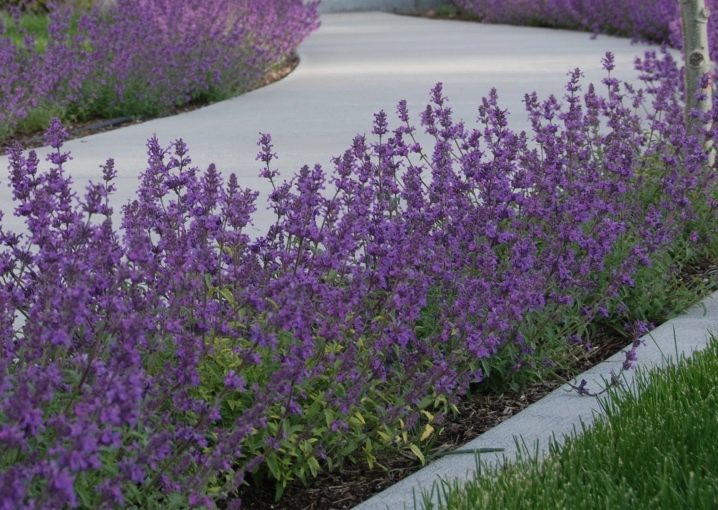Types and varieties of catnip

Airy blooming brushes of heavenly shades fill the garden with a pleasant aroma and attract pollinating insects. Around the tender shoots of catnip at the beginning of summer, there is always a constant hum of bumblebees and bees, attracted by the abundance of inflorescences and a strong scent with lemon notes.

On the territory of the Russian Federation, you can find about 80 varieties of this unique plant, and there are three times more of them all over the world.
Features of large-flowered catnip
The large-flowered catnip got its name for its unusual, almost narcotic effect on the representatives of the feline family, who cannot remain indifferent to its pleasant aroma. The catnip is a close relative of mint, but, in addition to the smell similar to it, its leaves secrete nepetalactone, which attracts animals. More and more gardeners are planting catnip not because of the love of their pets for it, but due to the high decorative qualities of the nectaronos, which has medicinal properties. Unpretentious shrub during the summer period adorns flower beds, decorated in the form of a variety of flower beds or alpine hills. Flowering bushes with small inflorescences, similar in shape to lavender, beautifully frame garden paths and go well with roses.



Various varieties of perennial plants grow in Siberia, in the dry and stony soil of the Caucasus Mountains, as well as in the middle zone of the European plain. In some areas, there is an annual catnip, the shoots of which reach 100-120 cm in height. In addition to the blue color of the inflorescences, there are plants with yellow or pink petals. For example, the Blue Dragon variety with a long flowering period pleases gardeners with its large blue-violet flowers throughout the summer months.

Among the representatives of the large-flowered catnip varieties, there are both spectacular beauties and varieties with a more modest appearance. However, many of them deserve attention not only for their decorative qualities. In some flowers, the aroma contains spicy inclusions, while in others, the smell resembles citrus fruits.

Some of them are used in traditional medicine, as well as to scare away small rodents, to which the spicy aroma signals danger.
Description of Fassen's catnip
The most commonly used in landscape design is Fassen's catnip, bred by Dutch breeders in the 30s of the last century. Over time, this sterile hybrid cultivar with silvery narrow leaves, which grows about 30 cm, gave rise to a whole line of decorative catnip varieties. On its basis, a dwarf variety Kit cat was bred, the shoots of which rise only 20 cm above the ground, and the bushes grow in a circle up to 30 cm.


English gardeners bred a powerful hybrid called Six Hills Giant from Fassen's catnip. The winter-hardy, hardy perennial Parsian blue is also a descendant of the Dutch variety and lends itself well to the artificial formation of compact, low bushes. The plant is able to withstand a drop in temperature in the cold season to -40 degrees. It belongs to an upright medicinal species of catnip with bright blue flowers on dense panicles. Another variety of Fassen's garden catnip is the Light blue variety, whose lilac flowers emit a pleasant and strong mint aroma throughout the summer. Low-growing bushes Junior Walker are resistant to dry weather and tolerate open sunny areas for planting.




Other popular varieties
Despite the fact that numerous varieties of catnip belong to the same family, different types of related plants differ in growth, flowering duration, color of leaves and flowers, as well as taste and medicinal qualities. Among them, the most attractive variety for landscape designers and lovers of decorative flowers is the Blue Panther variety with large flowers collected in tall spikelets.

Bushes grow from 30 to 50 cm and create vertical rows well in group plantings with other plants in flower beds. Shoots branch quickly and begin to bloom in the first year after planting in open ground.
One of the best honey plants and flower garden decorations is the Pink Panther catnip variety. Fragrant low perennials with erect spikelets of light lilac flowers of a pinkish hue look good both in single massive plantings and among flower beds. In addition to spike-shaped varieties, plants with racemose inflorescences, which create an airy carpet of heavenly color in the summer garden, are also of interest.

Multi-cut
The multi-cut catnip is found in the wild on the territory of the Russian Federation and Mongolia, where it grows on plain meadows or the slopes of mountainous areas overgrown with forbs. Its slender spikelet-shaped inflorescences are distinguished by a complex texture, as if incised along the edges. Low bushes of a drought-resistant perennial do not grow higher than 50 cm and branch weakly. Pointed foliage is covered with fine hairs, and yellow glands are located in the sinuses.

Veined
The type of catnip, belonging to the veinous variety, is a dwarf ground-cover bushes. The delicate foliage of a pale green color with a gray tint in the summer is crowned with blue inflorescences. When growing in the garden such varieties of veined catnip as Neptune or Pink Cat, faded areas of the shrub should be removed. Timely pruning extends the flowering period until the end of September.


Eesky
Fragrant perennial bushes of the Eesian catnip grow up to 1 meter high. Flowers about 3 cm long are located on the tops of straight, thickened stems. The leaves are long, with sharp tips and slight pubescence in the lower part. A rare plant found mainly in the north of the Japanese islands and is considered an endangered species.

Mussini
The perennial catnip mussini is cultivated mainly in the dry mountainous regions of the Caucasus. Its wrinkled grayish-green leaves contain a lot of essential oils with camphor and mint scent. An unpretentious plant requires minimal maintenance in the form of the necessary supply of nutrients in the soil and watering on the hottest days. Mussini blooms from early spring to mid-autumn, and cut stems with flower stalks are dried and used as a spice for cooking various dishes.

Kokand
The high-mountain meadows of China and Central Asia are the habitat of the Kokand catnip, which prefers semi-shaded areas of land with a high humus content. The bushes grow up to 40 cm, but have a large diameter due to the strong branching of the shoots. This variety of catnip begins to bloom with lilac petals from the middle of summer, and by the beginning of autumn it forms small rounded fruits.

It is propagated by dividing the bush or by seeds, which are sown in the spring in warm soil.
Cat mint
A separate subgroup of catnip is called catnip, and this name often applies to all members of the family.But catnip itself is distinguished by pronounced lemon notes in the aroma of flowers and leaves. The Velvet variety is distinguished by a special aroma, and the medicinal properties of catnip surpass its decorative value, since they have a positive effect on human well-being.

Bukhara
The catnip species Nepeta bucharica is widespread in the regions of Central Asia, where it is found in abundance on the banks of small rivers. In terms of growth, it can be attributed to the middle-sized representatives of the family with low and compact bushes, flowering brushes with blue-blue petals.

Isfahan
Among its fellows, the Isfahan catnip is distinguished by its low growth - only about 15 cm. In the wild, it grows in the flood plains of the Asian valleys and is an annual plant.

Semi-seated
A short shrub grows in the Kuril Islands and Japan. The growth of a semi-seated catnip does not exceed 40 cm, and it prefers dry soils, on mountainous slopes. The blooming brush is about 10 cm long, covered with blue petals with a blue edging. An unpretentious plant is successfully cultivated on various soils.

Its leaves with a grayish tint have the scent of lemon balm and medicinal properties.







The comment was sent successfully.